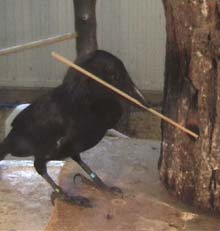Betty The Crow Is Right-Handed

Crow using dowelling to extract mealworms from a hole; holding it with the non-working end against its right cheek Credit: University of Oxford JPG
New Caledonian crows, known to be very proficient tool-users, have a preferred way of holding their tools comparable to the way humans are either right- or left-handed, according to research by Oxford zoologists, recently published in ’Biology Letters’.
Studying the tool use of 10 captive New Caledonian crows, the researchers found that each bird had a consistent preference for holding a piece of dowelling either near its left or its right cheek when trying to retrieve mealworms from a hole in a piece of wood. Five of the birds preferred to use tools left-laterally, and five right but laterality did not obviously differ between male and female crows.
The findings are surprising as it is rare to find animals with such exclusive lateral preferences for manipulative tasks. Only 50 per cent of chimpanzees, for example, are committed to always using the same hand for tool use.
Mr Alex Weir of the Behavioural Ecology Research Group at the Oxford University’s Department of Zoology said: ’Our results show that individuals have very strongly preferred ways to hold tools but there is no apparent population preference. This result is still preliminary, since the sample size is too small to firmly conclude that there is not population-level laterality.
’However these results appear to contrast with other research, which showed that crows have a population-level bias for manufacturing tools, suggesting that the manufacturing and use of tools in this species may have different neural underpinnings.’
Media Contact
More Information:
http://users.ox.ac.uk/~kgroup/tools/laterality.htmlAll latest news from the category: Life Sciences and Chemistry
Articles and reports from the Life Sciences and chemistry area deal with applied and basic research into modern biology, chemistry and human medicine.
Valuable information can be found on a range of life sciences fields including bacteriology, biochemistry, bionics, bioinformatics, biophysics, biotechnology, genetics, geobotany, human biology, marine biology, microbiology, molecular biology, cellular biology, zoology, bioinorganic chemistry, microchemistry and environmental chemistry.
Newest articles

Trotting robots reveal emergence of animal gait transitions
A four-legged robot trained with machine learning by EPFL researchers has learned to avoid falls by spontaneously switching between walking, trotting, and pronking – a milestone for roboticists as well…

Innovation promises to prevent power pole-top fires
Engineers in Australia have found a new way to make power-pole insulators resistant to fire and electrical sparking, promising to prevent dangerous pole-top fires and reduce blackouts. Pole-top fires pose…

Possible alternative to antibiotics produced by bacteria
Antibacterial substance from staphylococci discovered with new mechanism of action against natural competitors. Many bacteria produce substances to gain an advantage over competitors in their highly competitive natural environment. Researchers…





















